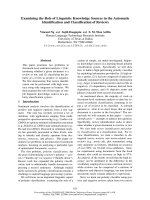Automatic control matlab exam
Bạn đang xem bản rút gọn của tài liệu. Xem và tải ngay bản đầy đủ của tài liệu tại đây (4.66 MB, 15 trang )
<span class="text_page_counter">Trang 1</span><div class="page_container" data-page="1">
<b>University of technology and education Ho Chi Minh cityFaculty of international education</b>
<b> Automatic control Matlab exam</b>
<b> Teacher: Vu Van Phong</b>
<b> Student: Tran Ngoc Xuan Thanh Student id: 20146280</b>
<b> </b>
<i><b> </b></i>
<i><b> TP HCM, Month 12 Year 2023</b></i>
</div><span class="text_page_counter">Trang 2</span><div class="page_container" data-page="2">Question 1:
Student id: 20146280 a=8 and b=1 -Code:
a) Define a function on Matlab I have a=8 and b=1
After that using G(fuction of system)=tf([1],[1,2*a+b,(a+b)/2,0]) to enter a and b and find G(s)
</div><span class="text_page_counter">Trang 3</span><div class="page_container" data-page="3">b) Draw a Numerical solution trajectory on Matlap
After that, I use rlocus to find a Numerical solution trajectory for a system on Matlab. I have the graph:
</div><span class="text_page_counter">Trang 4</span><div class="page_container" data-page="4">c) Find Kgh?
d) Choose any K such that the system is stable then simulate the system in Simulink with the obtained value of K and an input signal as a step function.
With K=0.3 the system is stable. I simulate the system in Simulink. I have a block diagram and the graph.
</div><span class="text_page_counter">Trang 6</span><div class="page_container" data-page="6">a)Draw a bode graph on Matlab
First, we I a G2=tf([100, 1800],conv([1 8],[1 11 1])) to enter a function(G2) on Matlab
I use a bode(G2) to draw a bode graph on Matlab and we have a graph:
</div><span class="text_page_counter">Trang 7</span><div class="page_container" data-page="7">b)Find a Phase and Magnitude
We can see a picture when I draw a bode graph on Matlab:
</div><span class="text_page_counter">Trang 8</span><div class="page_container" data-page="8">We have Phase(dự trữ Pha)=Pm and Magnitude(dự trữ biên)=Gm, so I have magnitude=infinity and phase=24,3degree(about 10,5 rad/s)
c)Comment on the stability of the system based on the Bode theory -The system is stable When:
+with Gm(Magnitude): Gm>1(db) the system is stable
+with Pm(Phase margin): 30(degree)<Pm<60(degree) is the best Pm for the system stable
-I have Pm=24,3 degree and Gm=infinity
+With Gm=infinity the system is stable because Gm>1
+With Pm=24,3degree, Pm<30(degree) the system may be stable but the system will become sluggish with disturbances and the system may be have a risk of overshoot\
</div><span class="text_page_counter">Trang 9</span><div class="page_container" data-page="9">-Based on the given information, the system will be stable, but there is a possibility of overshoot.
Question 3:
Student id: 20146280 so a=8 and b=1 -Code:
</div><span class="text_page_counter">Trang 10</span><div class="page_container" data-page="10">a)Draw a Nyquist graph on Matlab
I use G3=tf([8], conv([1 8], [1 11 1])) to enter the function on matlab
After that I use Nyquist(G3) to draw a Nyquist graph on Matlab:
</div><span class="text_page_counter">Trang 11</span><div class="page_container" data-page="11">b) Comment on the stability of the system based on the Nyquist theory -According to Nyquist, a system is stable if there is a loop on the Nyquist plot, but no point of the loop crosses the point -1 (1 + 0j); the system can still be
a) and b) Find a pole and zero of the system and draw on complex plane -We have a function G(s
)=
<i><sub>s</sub></i><small>2</small> <sup>1</sup><i><small>+s+ 9</small></i> because the numerator of function is =>we don’t have zero point
</div><span class="text_page_counter">Trang 12</span><div class="page_container" data-page="12">I use a pole(T4) and zero(T4) on Matlab to find a poles points and zero points
I use a pzplot(T4) to draw a pole point and zero point on complex plane
</div>








